Chemical hazards in industrial settings require comprehensive exposure risk management through hazardous material identification, robust industrial hygiene practices, and adherence to safety regulations. This involves assessing materials, implementing tailored controls like ventilation and PPE, using tools like MSDS and digital databases for accurate identification, and regularly monitoring and training workers to minimize accidents and foster safer environments. Physical barriers, such as enclosed systems and fume hoods, further mitigate risks by creating safe distances from hazardous substances. Effective chemical hazard management emphasizes continuous monitoring, maintenance, and adherence to industrial hygiene standards for optimal worker protection and environmental integrity.
Engineering controls are essential for managing chemical hazards in industrial settings. This article delves into critical aspects of chemical exposure risk management, beginning with understanding the nature and impact of chemical hazards. It explores key steps in hazardous material identification, vital industrial hygiene protocols, and the efficacy of various engineering controls, including physical barriers and ventilation systems. Additionally, it covers when and how to deploy personal protective equipment (PPE) and the importance of monitoring and maintenance for continuous risk management.
- Understanding Chemical Hazards: Their Nature and Impact
- Essential Steps in Hazardous Material Identification
- Industrial Hygiene Protocols: Creating a Safe Working Environment
- Engineering Controls: Physical Barriers and Their Efficacy
- Ventilation Systems: Managing Chemical Exposure Risks
- Personal Protective Equipment (PPE): When and How to Deploy
- Monitoring and Maintenance: Ensuring Continuous Risk Management
Understanding Chemical Hazards: Their Nature and Impact
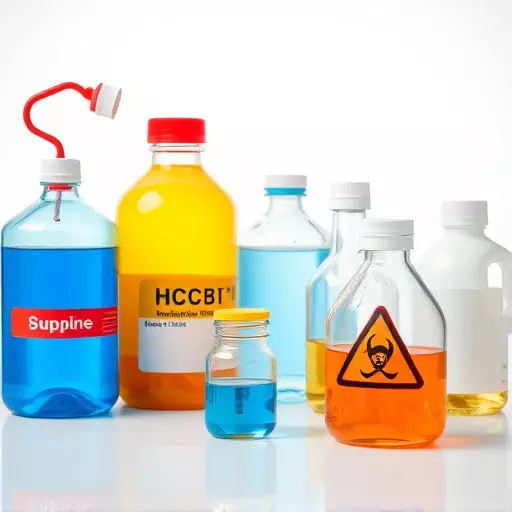
Chemical hazards are a significant concern in various industrial settings due to their potential for severe health impacts and environmental damage. Understanding these hazards involves recognizing their diverse forms, such as toxic substances, flammable materials, and corrosive agents, each presenting unique risks. Chemical exposure risk management is a critical aspect of industrial hygiene protocols designed to protect workers and communities.
Effective chemical hazard identification starts with assessing the materials handled within a facility. Implementing rigorous hazardous material identification processes enables organizations to implement tailored controls, ensuring compliance with safety regulations. By adopting comprehensive industrial hygiene practices, including regular monitoring and training, companies can minimize accidents, reduce exposure, and foster a safer working environment.
Essential Steps in Hazardous Material Identification
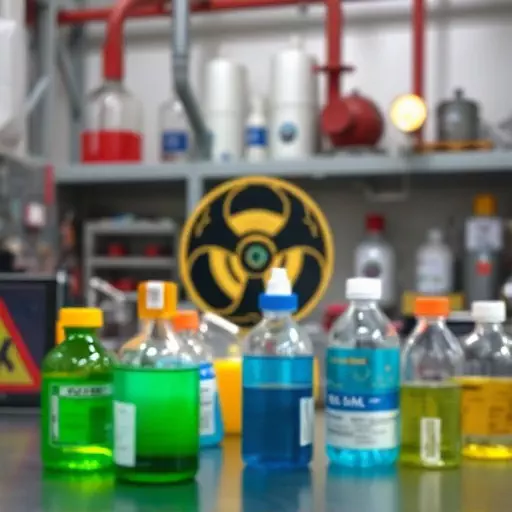
Identifying hazardous materials is a critical step in managing chemical exposure risks within industrial settings. The process begins with a thorough review of facility operations, including an inventory of all chemicals present or used on-site. This involves compiling detailed information about each substance’s purpose, quantity, and potential hazards associated with it. Industrial hygiene protocols demand that this be done regularly to ensure accuracy and adapt to any changes in the workplace.
Once the chemical inventory is established, advanced methods like material safety data sheets (MSDS) and digital databases can aid in precise hazardous material identification. These resources provide critical information about each chemical’s properties, including its toxicological profile, exposure limits, and necessary precautions for handling and storage. This data empowers workers to implement effective control measures, thereby enhancing overall industrial hygiene protocols and mitigating risks associated with chemical exposure.
Industrial Hygiene Protocols: Creating a Safe Working Environment
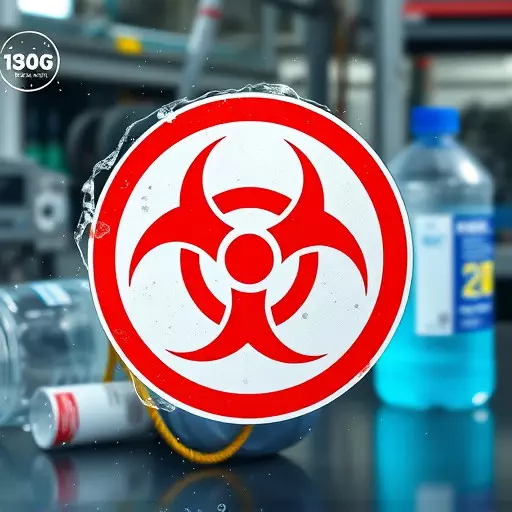
Industrial Hygiene protocols are a cornerstone in mitigating chemical exposure risks within industrial settings. These protocols focus on creating and maintaining a safe working environment by systematically identifying, evaluating, and controlling hazardous materials present in various work processes. The primary goal is to minimize or eliminate employee contact with chemicals that could pose potential health hazards.
Effective industrial hygiene practices involve conducting thorough hazard assessments, implementing engineering controls like ventilation systems, personal protective equipment (PPE), and safe handling procedures. By adhering to these protocols, organizations can significantly reduce the risk of chemical exposure, ensuring a healthier and safer workplace for all employees.
Engineering Controls: Physical Barriers and Their Efficacy
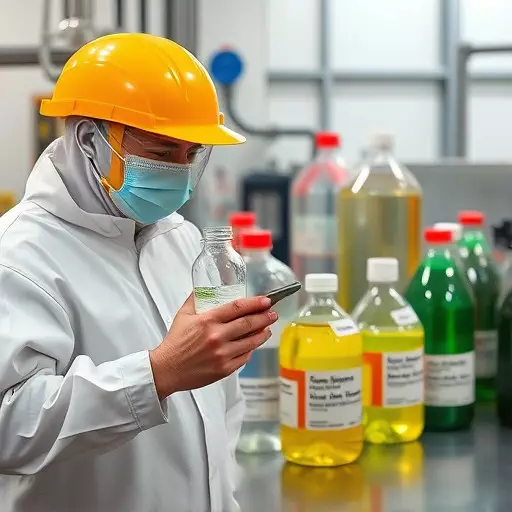
Engineering controls play a pivotal role in managing chemical exposure risks and upholding industrial hygiene protocols. Among these controls, physical barriers stand out for their effectiveness in containing hazardous materials. These barriers can take various forms, such as enclosed systems, fume hoods, and specialized containment areas. Their primary function is to prevent direct contact between workers and harmful substances, thereby reducing the risk of inhalation, skin absorption, or accidental release.
The efficacy of physical barriers lies in their ability to create a safe distance between employees and hazardous materials. By isolating processes involving toxic chemicals, these barriers ensure that even in the event of a leak or spill, the impact is confined, minimizing exposure potential. Proper selection and implementation of physical barriers are crucial steps in an overall chemical risk management strategy, complementing other controls like personal protective equipment (PPE) and administrative procedures to address hazardous material identification and handling.
Ventilation Systems: Managing Chemical Exposure Risks
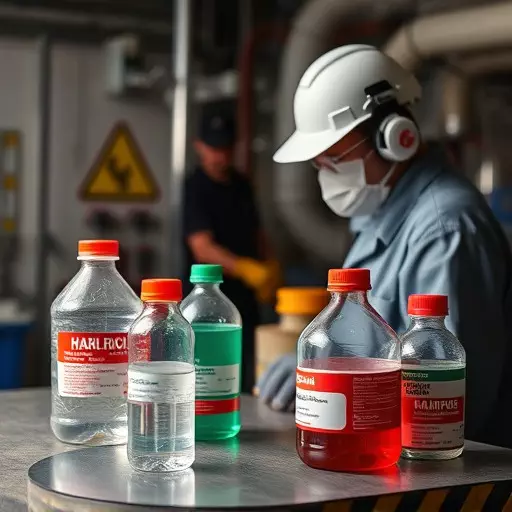
Ventilation systems play a pivotal role in managing chemical exposure risks within industrial settings. These systems are designed to control and minimize airborne contaminants, ensuring worker safety and maintaining environmental integrity. By implementing effective ventilation strategies, facilities can effectively mitigate the spread of hazardous materials and reduce the potential for adverse health effects.
Industrial hygiene protocols mandate regular inspections and maintenance of ventilation systems to ensure their optimal performance. Proper identification of hazardous materials is a crucial step in this process, as it allows for targeted ventilation solutions. For instance, local exhaust ventilation can be employed to capture and remove chemicals at their source, while general ventilation systems distribute clean air throughout work areas, diluting potential hazards. Such measures contribute to a comprehensive chemical exposure risk management strategy, upholding safety standards and promoting healthy working conditions.
Personal Protective Equipment (PPE): When and How to Deploy
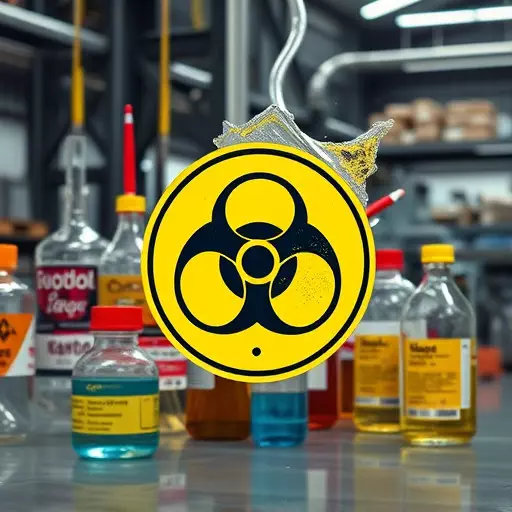
Personal Protective Equipment (PPE) plays a pivotal role in chemical exposure risk management, serving as a crucial component of industrial hygiene protocols. When dealing with hazardous materials, workers must be equipped with appropriate PPE to safeguard against potential risks. This includes specialized clothing, respirators, gloves, and eye protection, tailored to the specific chemical hazards present in the workplace.
The deployment of PPE is contingent upon a thorough hazardous material identification process. Employers should conduct comprehensive assessments to identify all potentially dangerous substances on-site. Once identified, they must then determine the level of risk associated with each chemical and select the most suitable PPE accordingly. Regular training sessions are essential to educate employees on proper PPE donning and doffing procedures, ensuring maximum protection against chemical exposure.
Monitoring and Maintenance: Ensuring Continuous Risk Management

Effective chemical hazard management relies heavily on continuous monitoring and maintenance, integral components of industrial hygiene protocols. Regularly assessing workplace environments for hazardous materials and their concentrations is crucial to identify potential exposure risks. This proactive approach ensures that any adverse health effects due to chemical exposure are promptly addressed.
Maintenance protocols should include regular calibration of detection equipment, proper disposal of contaminated materials, and training sessions for employees on recognizing and responding to hazardous situations. By upholding rigorous industrial hygiene standards, organizations can safeguard worker well-being, minimize environmental impact, and comply with legal obligations related to chemical exposure risk management.
